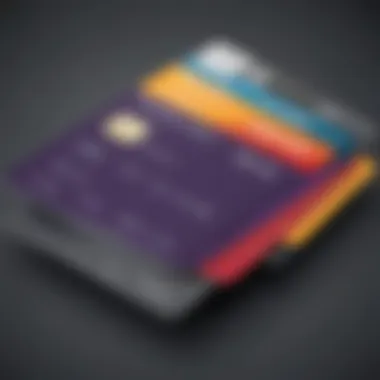A Guide to Large Credit Line Credit Cards Benefits


Intro
Navigating the landscape of large credit line credit cards can seem a bit overwhelming at first. For many individuals and businesses alike, understanding these financial tools is vital for achieving their financial goals. These high-limit cards offer not just a broader credit capabilities but also come with distinct advantages and potential pitfalls.
This section will provide a concise overview of what large credit line credit cards entail. They essentially serve as an extension of your borrowing potential, allowing cardholders to make larger purchases or finance expenditures that might otherwise strain their finances. However, with this opportunity comes additional responsibilities and risks.
"A credit card is a tool. Just like hammers and saws, it's critical to know how to use them wisely."
In this exploration, we’ll delve into several key areas: the benefits of obtaining large credit lines, the risks involved, and how to leverage these cards effectively. A solid understanding of these aspects can empower you to make informed decisions tailored to your unique circumstances.
In the next sections, we will examine various financial terms associated with credit cards and shed light on applicable strategies for both seasoned investors and everyday consumers. With proper knowledge, navigating the complex world of high-limit credit options becomes much less daunting.
Understanding Large Credit Lines
Understanding large credit lines is crucial to navigating the often complex world of credit cards. This section serves as a jumping-off point for grasping how these financial tools operate and the many ways they can impact an individual’s fiscal stability. Large credit lines can flexibly manage significant expenses, be they travel, emergency costs, or larger purchases. However, the ins and outs of credit lines can be somewhat daunting without proper insight.
Definition of Credit Lines
A credit line, or line of credit, is essentially an agreement between a lender and a borrower that gives the borrower access to a specific amount of funds. This arrangement enables individuals or businesses to draw money as needed rather than receiving a lump sum. In terms of credit cards, having a large credit line means that you can charge more to your card before hitting the limit set by the issuer.
Credit lines are generally categorized based on whether they have a set repayment schedule or maintain a revolving structure. Understanding the fundamental definitions and characteristics of credit lines can significantly enhance one’s ability to choose the right financial products.
Types of Credit Lines
Credit lines can broadly be divided into two categories: revolving credit and installment loans.
Revolving Credit
Revolving credit is a flexible form of borrowing. It allows users to access their credit limit repeatedly without the need to apply for a new loan each time. For instance, many credit cards operate under this model. A key characteristic of revolving credit is that, as you pay down your balance, your available credit goes back up, making it a popular choice among consumers.
One unique feature of revolving credit is the lack of a fixed payment schedule. This offers borrowers greater flexibility as they can manage their repayments based on their own financial situations. However, this can also lead to potential overspending, which might trap borrowers in a cycle of debt if not handled responsibly.
Installment Loans
On the other hand, installment loans operate under a different model. These loans provide a borrower with a lump sum that is then paid back in fixed amounts over a predetermined period. Car loans and mortgages are prime examples of installment loans. A noteworthy aspect of these loans is that they typically come with a fixed interest rate, providing predictability in repayments.
Installment loans tend to be beneficial for individuals looking to finance larger purchases in a manageable way. However, the rigidity of the repayment schedule can pose challenges if one’s financial situation changes unexpectedly.
Difference Between Secured and Unsecured Credit Lines
When evaluating credit lines, it’s essential to discern between secured and unsecured options. Secured credit lines are backed by collateral—say, a savings account or property—meaning if the borrower defaults, the lender can claim the asset. Unsecured credit lines, on the other hand, are not attached to any collateral. They generally reflect the borrower's creditworthiness based on their income and credit history.
Secured credit lines can often come with lower interest rates due to the lesser risk involved for lenders. However, they require a tangible asset, creating an added layer of complexity. Unsecured lines, although more accessible in many instances, could lead to higher interest rates if the borrower has a less-than-stellar credit score.
Understanding these nuances allows consumers to make informed choices regarding which type of credit line aligns with their financial goals and risk tolerance.
Benefits of Large Credit Line Credit Cards
When it comes to managing personal finances, large credit line credit cards provide an avenue for enhanced control and opportunities. These cards come with various advantages that can significantly benefit cardholders, especially those who maintain diligent financial habits. Understanding these benefits lays the groundwork for making informed decisions regarding credit management. In this section, we will examine the pivotal elements that make large credit line credit cards an appealing option for consumers.
Improved Financial Flexibility
One of the standout features of large credit lines is the flexibility they offer. With a substantial credit limit, you are not confined to just your regular budget, which can come in handy during emergencies or unexpected expenses. It means you have room to maneuver when your financial landscape shifts. This flexibility allows users to manage cash flow more effectively, reducing the stress associated with tight budgets. It can also facilitate larger purchases without impacting your monthly budget restraint, making it easier to invest in valuable experiences or essential goods.
Potential for Higher Rewards
Using a credit card with a significant line allows users to accrue rewards more efficiently. Credit card companies often offer various incentives, which can enhance the overall value of using these cards.
Cashback Offers
Cashback offers are a popular feature of many credit cards today. The simplicity of earning back a percentage of your spending makes it rather appealing. For instance, if you spend $1,000 and have a 2% cashback rate, you will receive $20 back. These programs are beneficial because they provide a tangible benefit for spending that might have occurred anyway. However, one must note that the key characteristic is thoughtful spending; if the cardholder overspends unnecessarily, the cashback gained can be far less valuable when considering interest payments. Hence, a zero-cost cashback approach hinges on responsible usage rather than runaway spending.
Travel Rewards
Travel rewards can be dazzling for frequent travelers. Oftentimes, these cards allow users to gather points or miles that can be redeemed for flights, hotel stays, or car rentals. Imagine saving enough points through regular expenditures to book a vacation without adding to your overall expenses. This kind of incentive can turn everyday spending into a platform for unique experiences. Yet, it's essential to stay aware of specific terms; redeeming rewards might come with restrictions related to availability or potential blackout dates.
Enhanced Credit Score Management
Having a large credit line can also play a critical role in maintaining and potentially improving your credit score. Credit utilization – the ratio of debt to available credit – is a major determinant in credit scoring. By keeping spending well below the credit limit, you can show creditors that you can manage available credit responsibly. This image of financial stability can lead to a higher credit score over time. Additionally, if you handle payments on time and in full, your credit profile continues to grow stronger, further enhancing your financial standing.
Managing a large credit line responsibly not only opens doors to immediate rewards but can contribute significantly to long-term financial health.
In a nutshell, large credit line credit cards offer numerous advantages. Whether it’s improved financial flexibility, the opportunity for higher rewards, or better credit management, their potential can serve as an asset in one’s financial strategy. By keeping an eye on responsible usage, cardholders can navigate the pitfalls often associated with high credit limits while enjoying their benefits.


Eligibility Criteria for Large Credit Lines
Understanding the eligibility criteria for large credit lines is like holding a key to the financial kingdom. This section lays down the groundwork that’ll help you navigate through the maze of credit options. By knowing what lenders look for, you can be well prepared when applying for such credit, ensuring that you resonate with the expectations of the financial institutions.
The eligibility criteria generally focus on three primary pillars: credit score, income, and debt-to-income ratio. Each of these elements plays a crucial role in determining whether one qualifies for a large credit line. Let’s break down these factors to see how they contribute to your overall financial profile, and how positioning yourself effectively can bolster your chances of approval.
Credit Score Requirements
A good credit score isn’t just a badge of honor; it’s often the golden ticket to accessing higher credit limits. Lenders typically have minimum credit score requirements that applicants must meet, with many prefering scores in the range of 700 or above. A healthy credit score suggests to lenders that you’re a responsible borrower, capable of managing debt.
When lenders sift through applications, they often look closely at three main components of a credit score:
- Payment History: This section accounts for a significant chunk of your credit score. Missing payments or defaults can knock it down faster than a hot knife through butter.
- Credit Utilization Ratio: This represents the amount of credit you’re using relative to your total available credit. Keeping this ratio below 30% is generally advisable, as it reflects your ability to not overextend financially.
- Length of Credit History: Longer payment histories can paint a better picture for lenders, showing consistent patterns over time.
Improving credit score can take time, but staying diligent with payments and managing current lines of credit can lead to gradual improvements.
Income Considerations
Now, let’s chat about income. Lenders want to ensure that you can pay back what you borrow, and your income is a big part of that equation. They often ask for documentation to verify your paycheck, and that might include recent pay stubs, tax returns, or W-2 forms.
The type and stability of income can also factor into the decision. For example, a permanent job may weigh more favorably than freelance gigs or contract work, which can be perceived as less stable.
If you’re self-employed, ensuring clear records and demonstrating consistent revenue can aid your application immensely. In some cases, showing additional sources of income—like investments or rental properties—could strengthen your position.
Debt-to-Income Ratio
The debt-to-income ratio (DTI) is another critical figure in the eligibility mix. Simply put, this measures how much of your income is allocated to existing debts. Lenders usually prefer a lower DTI, generally around 36% or less, as it illustrates that there’s enough financial room for you to take on additional credit.
To calculate your DTI:
- Add up your monthly debt payments. This includes things like mortgage, car loans, and prior credit lines.
- Identify your gross monthly income. This is your income before taxes and other deductions.
- Divide your total monthly debt by your gross monthly income. The result is your DTI percentage.
Example Calculation:
If you have $2,000 in total monthly debt and a gross monthly income of $5,000:
A 40% DTI might signal to lenders that you have more debt than they’re comfortable with, making it a potential red flag for approving a high credit line.
Knowing your eligibility criteria can be the difference between a green light and a red stop sign when it comes to applying for large credit lines.
In sum, if you want to reel in those substantial credit lines, focusing on enhancing your credit score, demonstrating a stable income, and managing your debt-to-income ratio is crucial. Taking time to align these factors with lender expectations can set the stage for successfully obtaining the credit you desire.
Potential Risks Associated with Large Credit Lines
When diving into the world of large credit line credit cards, it’s crucial to keep in mind the possible pitfalls that accompany such financial tools. These risks can be significant for those who might not fully understand how to manage a higher credit limit or who may not have disciplined financial habits. Recognizing these risks can help users navigate their credit options more effectively, ensuring that they reap the benefits without falling into common traps.
Overspending Risks
Overspending is arguably one of the biggest dangers tied to having access to large credit lines. While it may feel like a safety net, a high credit limit can unintentionally encourage spending beyond one’s means. It can be quite tempting to treat that large credit line as extra cash rather than a loan that must be repaid. This can lead to a vicious cycle of debt accumulation.
Some might think, "Just a little more won’t hurt!" But the reality is, every swipe at that shiny new credit card adds up. Before long, consumers can find themselves in a financial bind, struggling to pay back what they owe. It's important to create a budget to track spending and stay aligned with personal financial goals, making it easier to resist the urge to overspend.
Interest Rate Concerns
Another issue that often lurks in the background is the interest rate tied to large credit line cards. Many think a limit of $20,000 means they can spend freely, but if that balance isn’t paid off promptly, the interest can become a beast. Unlike a bank loan, credit cards typically come with variable rates that can fluctuate over time. One moment you might have a low interest rate, but the next, it could skyrocket.
Every time you carry a balance, you’re potentially looking at a larger debt than anticipated due to accruing interest. So, it’s crucial for cardholders to remain vigilant about understanding their rates, especially if they fail to pay their bill on time. Being trapped in high-interest debt can create a suffocating feeling, making it even harder to gain control over one’s finances.
Impact on Credit Score Due to Mismanagement
Finally, mismanagement of a large credit line can negatively affect your credit score. This score is a critical number that determines your future borrowing power and even your potential job opportunities. If a cardholder regularly dips into their credit limit or misses payments, their score is poised to drop like a rock.
Here’s what often happens: missed payments can lead to late fees, while high credit utilization ratios (i.e., using a large percentage of your available credit) can signal to lenders that you might be in financial trouble. A few late payments can haunt a credit report for years, affecting loan approval or interest rates on future borrowing.
"A credit score reflects your approach; mismanagement can lead to a tightrope walk over financial ruin."
To keep credit favorable, consistent on-time payments are vital. Setting reminders or utilizing auto-pay features can be effective strategies to stay on top of payments and maintain that all-important credit score.
In summary, while large credit lines can offer enticing benefits, they come with substantial risks. Being aware of factors like overspending, interest rates, and credit scores is essential for anyone looking to navigate the landscape of high-limit credit cards effectively. Understanding these potential pitfalls can lead to smarter financial choices and ultimately greater financial security.
Strategies to Maximize a Large Credit Line


Maximizing a large credit line can turn a potential financial burden into an opportunity. With the right strategies, you can not only enhance your purchasing power but also bolster your credit profile. This section explores several key tactics that can help you make the most of a high-limit credit card, ensuring that you use it wisely while reaping maximum benefits.
Building a Credit History
Establishing a robust credit history is integral when aiming to maximize a large credit line. A strong history ensures lenders view you as a low-risk borrower, which may result in higher credit limits in the future. Here's how to build that history effectively:
- Timely Payments: Always pay your bills on time. Late payments can tarnish your credit score, reducing your chances of receiving a larger credit line.
- Use Different Types of Credit: Don't just rely on credit cards; consider adding loans, like auto or student loans, to diversify your credit portfolio. This diversification shows lenders you are capable of handling various forms of debt.
- Keep Your Credit Utilization Low: It’s advisable to keep your credit utilization below 30% of your available credit. For example, if you have a $10,000 credit limit, try to use no more than $3,000 at any given time. This demonstrates responsible usage and can boost your credit score.
Building a solid credit history might seem tedious, but it pays dividends down the road, particularly when those extra dollars in a credit line come in handy.
Using Credit Responsibly
Responsible credit usage is essential when you have a large credit line. Knowing the difference between needs and wants is crucial here. With a bit of discipline, you can make your credit work for you, not against you:
- Set a Budget: Planning is half the battle. Create a clear budget that includes not just your fixed expenses, but also any purchases you might make with your credit card. Marking a specific amount you will spend can keep you aligned with your financial goals.
- Avoid Impulsive Purchases: It's easy to swipe a card and think nothing of it. However, training yourself to pause and consider whether a purchase is necessary can lead to better financial decisions in the long run.
- Leverage Rewards: If your card offers reward points or cash back, use these perks wisely. Plan your spending around categories that provide the most rewards, but always remember to pay off your balance to avoid interest charges.
By embracing responsible credit use, you not only avoid pitfalls, like overspending, but you also position yourself to benefit from the advantages that come with having a large credit line.
Regular Monitoring of Account Activity
Keeping a close eye on your credit card usage is a critical aspect of maximizing your large credit line. Regular monitoring can help you not only understand your spending habits but also ensure you don't neglect any important details:
- Check Statements Frequently: Quality control matters. By reviewing your statements every month, you can quickly spot any unauthorized transactions or mistakes that need correction. This can protect your finances in the long run.
- Utilize Alerts: Setting up alerts on your credit card can keep you informed about your spending limits and transactions. Many banks offer mobile strategies like text alerts that notify you of unusual activities or when you're approaching your limit.
- Assess Your Spending Patterns: Take the time to analyze where your money is going each month. Knowing your spending habits can guide you to make adjustments or set new financial goals. Being proactive about this can enhance your credit habits significantly.
Regular monitoring not only prevents mismanagement but also empowers you with knowledge about your financial health, ultimately enabling you to maximize the potential of your large credit line effectively.
"Being mindful of your credit usage today can lead to greater financial freedom tomorrow."
Comparing Large Credit Line Cards
When diving into the realm of large credit line cards, it's crucial to set aside some time to compare various offerings. This section serves to illuminate why it's not just wise, but essential, to scrutinize the array of cards available. A well-rounded comparison enables one to identify which features cater best to individual financial habits and needs.
To be specific, large credit lines can come with a host of different features, perks, and potential downsides. By zeroing in on what each card offers, consumers can make informed choices that align with their financial goals. This isn’t just about picking a card; it’s about finding the right ally in your financial journey.
Key Features to Consider
Annual Fees
An often overlooked yet significant aspect of credit cards is the annual fee. This fee can vary dramatically among different cards and can greatly influence the overall value a card offers. Some cards boast no annual fee at all, while others may charge fees that seem steep at first glance. For instance, a card charging $200 annually might offer plenty of rewards that could easily offset that cost if used strategically.
- Key Characteristic: The primary role of this fee is to act as a gateway for certain privileges. Cards with higher annual fees often provide superior benefits like travel credits, exclusive access to events, or higher rewards.
- Unique Feature: Some cards allow for waivers of the annual fee if you spend a certain amount each year, which can be attractive to regular spenders.
- Pros and Cons: It’s a balancing act; while no annual fee cards are popular for their cost-effectiveness, they may not offer the rewards programs that come with premium options, leaving you to weigh whether the benefits justify the cost.
Interest Rates
Interest rates on credit cards, often thought of as the black sheep of the credit card factors, can make a significant impact depending on one's spending habits. If you tend to carry balances from month to month, the difference between a low-interest and high-interest card can dig into your wallet pretty fast.
- Key Characteristic: Interest rates can fluctuate based on market factors and individual creditworthiness, so it’s important to read the fine print. Typically, cards with large credit lines come with competitive rates, but this isn't a universal rule.
- Unique Feature: Some credit cards offer introductory 0% APR for a limited time, which can be useful when managing larger purchases without accumulating interest.
- Pros and Cons: High-interest rates can lead to significant debt if balances are not paid promptly. Conversely, lower rates can mean substantial savings in the long run, especially for those who are disciplined in their payment habits.
Rewards Programs
The allure of rewards programs often lures consumers into applying for particular credit cards. These programs vary widely, with some offering cashback on all purchases, while others focus on travel points or specific categories like dining or groceries.
- Key Characteristic: Rewards programs allow cardholders to earn points or cashback that can be redeemed in various ways, adding value to everyday spending.
- Unique Feature: Certain cards partner with airlines or hotels, providing opportunities to accumulate points faster—and sometimes offering exclusive deals.
- Pros and Cons: While rewards programs can provide excellent returns on spending, it’s crucial to assess whether one is likely to use the card in a way that maximizes rewards. It’s easy to get caught up in the glamour of points and overlook the terms attached to redeeming them.
Card Issuer Reputation
A card’s issuer plays a vital role in your overall experience. Certain companies are known for their customer service, while others may have reputations marred by fees and complications. It’s advisable to research your potential issuer’s reputation before committing.
User Reviews and Experiences
Finally, looking through user reviews can provide insight into real-world applications of these credit cards. Often, personal experiences shed light on aspects that might not be covered in promotional materials. Checking platforms like Reddit can yield diverse opinions that help make the choice clearer.
"Choosing a credit card is like picking a partner; you want reliability, compatibility, and the ability to handle life’s little emergencies together."
Application Process for Large Credit Line Credit Cards
Navigating the application process for large credit line credit cards can seem daunting. However, understanding this journey is crucial for anyone looking to leverage these financial tools effectively. The stakes are high, and making informed choices can pave the way for better financial management in the future.
Researching Options
Before jumping headfirst into applications, it’s vital to spend time researching available options. Not all credit line cards are created equal. Each has its own set of features that can suit your unique needs. Factors to consider include:
- Credit Limits: Not all providers offer the same limits. Understanding your expected credit limit can help you gauge which cards may be suitable.
- Interest Rates: Look into the annual percentage rates (APRs) for new purchases and cash advances. Some cards might tempt you in with low introductory rates, only to introduce high interest rates down the line.
- Rewards & Perks: Many cards come with enticing rewards programs. Determine if you prefer cashback, travel rewards, or maybe even points towards future purchases.


An effective method is to create a shortlist of options and analyze user reviews across platforms like Reddit, ensuring you choose a credible option that matches your financial habits.
Submitting Your Application
Once you’ve done your homework and narrowed down your options, it's time to submit your application. This part can be nerve-wracking, given that the outcome can significantly impact your financial future. Here’s what to keep in mind:
- Accurate Information: Ensure that all details, from your income to your Social Security number, are accurate. Any discrepancies can cause delays or outright denials.
- Financial Documents: Be prepared to submit documentation proving your income and employment status. This may include pay stubs, tax returns, or bank statements.
- Credit Score: Check your credit score beforehand. Knowing where you stand can give you an idea of which cards you might reasonably be approved for.
Some applicants have found success simply by being thorough and prepared. Make it a habit to double-check everything before you hit that submit button.
Understanding Approval Timing
Once you’ve sent in your application, patience becomes key. Different card issuers follow varying timelines for approvals, and understanding this can ease the waiting game. Consider the following:
- Instant vs. Manual Reviews: Some companies provide instant approvals, while others may require a manual review of your application. Be ready for a waiting period that can stretch from a few minutes to several days.
- Follow-up Options: If your application is delayed, don’t hesitate to follow up with customer service for clarification on your status. Knowing where you stand can alleviate some of the uncertainty.
- Conditional Approvals: In some cases, you might receive a conditional approval. This usually means there are additional steps needed before you get the card. Be proactive about fulfilling any requirements to finalize your approval.
The application process can feel like a rollercoaster if you’re not well-prepared. But with the right knowledge and careful steps, you can set yourself up for success.
Understanding the essence of each application step is not just about getting approved; it’s about laying a solid foundation for managing a large credit line responsibly. Embrace this process with the right mindset, and you’ll find the path toward financial freedom clearer.
Maintaining a Healthy Credit Line
When it comes to managing large credit lines, the concept of maintaining a healthy credit line is paramount. It's not just about having access to a significant amount of funds; it’s about using that credit responsibly to foster ongoing financial stability. Being prudent in your approach not only safeguards your credit score but also enhances your overall finance maneuverability. Here, we delve into the crucial elements that make up this essential endeavor.
Timely Payments and Their Importance
One of the most straightforward yet overlooked aspects of credit management is making timely payments. Life can throw curveballs; bills stack up, and unexpected expenses arise. However, missing even a single payment can have a ripple effect on your credit score.
Many credit card issuers report payment history to the credit bureaus, making these delays very impactful. A missed payment can drop your score significantly, sometimes right when you need that credit the most. Setting up automatic payments can be a lifesaver, ensuring you never miss a beat. Also critical is understanding the due dates clearly. Keep an eye on those dates by marking your calendar or setting reminders on your phone. The benefits of consistent payments extend beyond just score maintenance; it reflects fiscal responsibility and can even set you up for better rates in the future.
Handling Emergencies Without Overextending
Emergencies are a fact of life. Whether it's a busted pipe or a sudden medical bill, it’s essential to tackle these situations wisely. With high credit limits, it can be tempting to dip into those funds impulsively. The key is to balance immediate needs against long-term financial health.
Here’s how to navigate emergency spending:
- Assess Necessity: Before swiping that credit card, evaluate whether the expenditure is genuinely necessary. Can it wait? Is there a less costly alternative?
- Have a Plan: If you must use your credit line, have a repayment plan in mind. Set a timeline for when you intend to pay it back to avoid falling into a pit of high-interest debt.
- Keep an Eye on Your Usage: Ensure that using your credit for emergencies doesn't lead to chronic overextension. Having a credit line doesn't mean it should be fully utilized without consideration.
Reviewing Statements Regularly
Regularly monitoring your statements is an often undervalued practice. Each month, take the time to sit down and review not just the balances but the little details.
Points to Pay Attention To:
- Identify Unusual Charges: Spot anything that doesn’t appear familiar? Investigate it. Fraud and identity theft can creep into blissfully unaware bank statements.
- Track Spending Patterns: Put a microscope on your spending to identify where you might be overspending. Is there a recurring subscription you had forgotten about? It’s easy for small fees to add up, creeping toward what could become an unmanageable balance.
- Understand Your Interest Accrual: Know how much interest you’re accumulating. Understanding this can also incentivize you to pay off your balance quicker.
Keeping a pulse on your statements will help to not only avert unforeseen financial pitfalls but will also provide insight into how you can improve your spending habits. In the grand scope of credit management, taking the time to effectively monitor and manage your account plays a significant role in maintaining a healthy credit line.
"In the world of finance, a little vigilance goes a long way. No one is immune to slips, so being proactive can make all the difference."
Ultimately, maintaining a healthy credit line requires attentiveness to detail and a commitment to smart financial practices. Incorporate these strategies to safeguard your credit and empower your financial situation.
Closure and Future Trends in Credit Lines
As we reach the end of this extensive exploration into large credit line credit cards, it’s essential to reflect on what has been discussed and how it sets the stage for future financial landscapes. Understanding these cards goes beyond just knowing their features; it involves recognizing their impact on personal finance and economic well-being. The ability to manage a large credit line responsibly can enhance financial flexibility, but it also carries weighty responsibilities that shouldn’t be taken lightly.
Sustainable Credit Practices
One of the primary themes underscoring the future of credit lines is the move towards sustainable credit practices. As financial institutions face increasing scrutiny and regulatory demands, their focus is shifting towards promoting responsible borrowing. Sustainable practices encompass a range of factors, including the encouragement of late-payment fees and better financial literacy among clients.
- Community Education: Institutions are likely to invest in consumer education programs to help individuals understand credit management better.
- Limit Adjustments: Many creditors may consider offering flexible credit limits that reflect not just creditworthiness but also the borrower’s earning potential and spending habits.
- Promotions of Financial Wellness: A trend towards financial coaching and personalized financial management tools will likely grow, as lenders feel more responsible for the outcomes of their customers.
With these actions, lenders aim to create a healthier borrowing environment for all.
Evolving Financial Technologies
We are witnessing an exciting evolution in financial technologies that could redefine the landscape of credit lines. Fintech innovations are not only making processes faster but also more transparent and user-centered. The integration of AI and machine learning into credit scoring systems can lead to more accurate assessments of risk.
- Real-Time Credit Management: Imagine apps that allow you to monitor your spending, provide alerts before approaching your credit limit, and suggest budgeting methods tailored to your financial habits.
- Streamlined Applications: Enhanced user experience through digitized applications might become standard, making it simpler for potential cardholders to obtain credit lines.
- Blockchain Technology: As this technology continues to mature, its application in credit evaluations could allow for a more decentralized and secure method of managing financial records.
These developments can provide users with greater control over their finances.
The Future Landscape of Credit Products
The future landscape of credit products is expected to adapt to evolving consumer needs and technological advances. No longer will the system be solely focused on traditional scoring methods and rigid credit products. Instead, there will be a more inclusive approach aimed at reaching a broader audience.
- Diverse Product Offerings: Lenders may develop innovative credit solutions such as personal lines of credit bundled with financial advice services.
- Customized Rewards and Benefits: We might see credit cards tailored to specific demographics or lifestyles—offering perks that resonate more with targeted consumers.
- Enhanced Transparency: Expect financial products that come with clear and straightforward fee structures, aimed at building trust.
By adapting to these new demands, financial institutions will foster a relationship of mutual growth and accountability, enabling a healthier credit landscape for consumers.
In sum, the exploration of large credit line credit cards provides valuable insights. By focusing on sustainable practices, leveraging technology advancements, and anticipating future credit product developments, we position ourselves to make more informed choices in an ever-changing financial arena.







